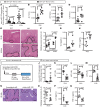Hypoxia-inducible factor-1α-dependent induction of miR122 enhances hepatic ischemia tolerance
- PMID: 33792566
- PMCID: PMC8011886
- DOI: 10.1172/JCI140300
Hypoxia-inducible factor-1α-dependent induction of miR122 enhances hepatic ischemia tolerance
Abstract
Hepatic ischemia and reperfusion (IR) injury contributes to the morbidity and mortality associated with liver transplantation. microRNAs (miRNAs) constitute a family of noncoding RNAs that regulate gene expression at the posttranslational level through the repression of specific target genes. Here, we hypothesized that miRNAs could be targeted to enhance hepatic ischemia tolerance. A miRNA screen in a murine model of hepatic IR injury pointed us toward the liver-specific miRNA miR122. Subsequent studies in mice with hepatocyte-specific deletion of miR122 (miR122loxP/loxP Alb-Cre+ mice) during hepatic ischemia and reperfusion revealed exacerbated liver injury. Transcriptional studies implicated hypoxia-inducible factor-1α (HIF1α) in the induction of miR122 and identified the oxygen-sensing prolyl hydroxylase domain 1 (PHD1) as a miR122 target. Further studies indicated that HIF1α-dependent induction of miR122 participated in a feed-forward pathway for liver protection via the enhancement of hepatic HIF responses through PHD1 repression. Moreover, pharmacologic studies utilizing nanoparticle-mediated miR122 overexpression demonstrated attenuated liver injury. Finally, proof-of-principle studies in patients undergoing orthotopic liver transplantation showed elevated miR122 levels in conjunction with the repression of PHD1 in post-ischemic liver biopsies. Taken together, the present findings provide molecular insight into the functional role of miR122 in enhancing hepatic ischemia tolerance and suggest the potential utility of pharmacologic interventions targeting miR122 to dampen hepatic injury during liver transplantation.
Keywords: Gastroenterology; Gene therapy; Hypoxia; Organ transplantation; Transplantation.
Conflict of interest statement
Figures






References
-
- Pirenne J, et al. Influence of ischemia-reperfusion injury on rejection after liver transplantation. Transplant Proc. 1997;29(1–2):366–367. - PubMed
Publication types
MeSH terms
Substances
Grants and funding
LinkOut - more resources
Full Text Sources
Other Literature Sources
Medical
Miscellaneous

